
This Triumph TRW looks tiny and lost as it stands in front of two towering Foden trucks, both carrying 05 registrations and ready to hit the highways on March 1. Funny place to keep a bike, you might think, but owner Peter Beckwith is the yard manager for EH Smith Building Supplies in Birmingham and the nice Mr Smith lets him keep his 1949 6T Thunderbird and this 1964 TRW military model here. In fact, company founder EH started off doing deliveries with a motorcycle and sidecar, so there’s an inbuilt sympathy for a good bloke like Peter who appreciates a little bit of space to keep and maintain his bikes.
It’s a long time since I had a ride on a well-used but healthy TRW, a bike that seems to be very good at making friends with people who don’t want to push their luck and the speed limits on every journey. You see the bikes on Vintage Club runs, quietly getting on with this new civilian job of being a gentleman’s affordable motorcycle; gentlemen like the late George Yeomans, of spares fame, who had one as his last regular riding bike and clearly liked it very much. They’re not fast, not top spec in the chassis department and not rendered overweight by lots of unnecessary gewgaws that bewilder the rider with information not vital to the simple matter of riding a motorcycle and enjoying it. “When CBG used to have the prices and descriptions in the back, it said the TRW had quiet charm if you’re not in a hurry, and that was absolutely right,” says Peter.
So today will not be hurried, which is not a bad recipe for life unless you’re a City futures broker who must know the price of coconut husks in Guatemala before dashing to keep that appointment with Septimus in the wine bar. On such things vital to life are some people’s daily priorities based. Pity them, poor buggers.
I remember this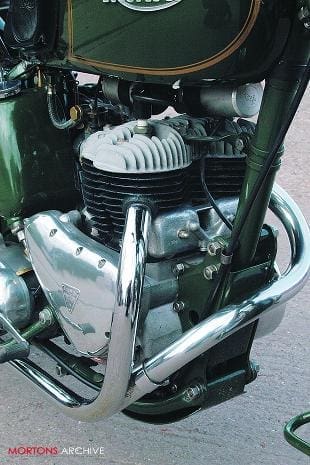 bike from years ago, when CBG organised a classic display and concours at a show based on a drag race meeting, for reasons never quite clear. In the line-up was this very smart Triumph TRW, the side-valve 500cc twin that was standard issue to the Nato forces in the 1950s and 60s. Dave Minton was the judge on the day and explained that he hadn’t given a prize to this bike, apparently right in every detail, because it was too brightly finished and not like the TRWs he’d ridden during his RAF days.
bike from years ago, when CBG organised a classic display and concours at a show based on a drag race meeting, for reasons never quite clear. In the line-up was this very smart Triumph TRW, the side-valve 500cc twin that was standard issue to the Nato forces in the 1950s and 60s. Dave Minton was the judge on the day and explained that he hadn’t given a prize to this bike, apparently right in every detail, because it was too brightly finished and not like the TRWs he’d ridden during his RAF days.
Minton is a knowledgeable chap and, as he served his time in the RAF, he spoke from experience. But, when any branch of the military had to put a little dash into its public display, like escorting a visiting dignitary, they had motorcycles with a finish that wouldn’t look tatty alongside a Humber staff car that had been polished that morning; it was apparently called the VIP Finish. It’s rather like the bank manager cleaning his shoes when he knows Editor Tim is paying him a visit, because it pays to keep well in with Top People.
Peter Beckwith bought his TRW in this state from GB Classics in Wiltshire, with no idea who had done such a lovely job of restoring it. Then he was at a country show – “I like the small shows, much more friendly, and I always ride the bike there,” he explains – when an elderly gent told him it used to be his bike, and he was delighted to see it being looked after properly. He was an ex-Rolls-Royce coach painter and had hand-painted the Triumph and then applied the gold lining by hand, too. By jingo, it’s a remarkably fine finish to get with just a humble paintbrush. Plus years of Rolls-Royce experience, of course, which probably helped.
This is the bike Peter uses all year round, for club runs, visiting shows and the Isle of Man, or just taking a ride when the mood is on him. “I’m not a fast rider,” he insists. “In fact, I’m renowned for being easy on the bike, but it isn’t difficult keeping up with mates on a long run. And it does cover ground well, even if you’re only cruising at about 50. I set out one day for a ride into Wales and ended up at Aberystwyth, it was so easy.”
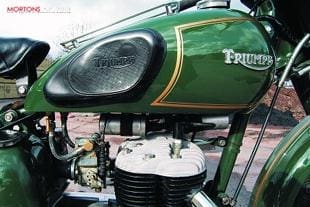 Then there was the rider of a modern sports bike who told ‘slow’ Peter he couldn’t stay with him down a winding country road. What we’re considering in that case is a missile designed for wide highways and gentle curves, in vain pursuit of a bike built to move down tight roads and across country with ease, plus the bloke in the saddle who clearly has some experience under his belt. As he puts it: “All that weight is low down, so it’s bound to handle well.”
Then there was the rider of a modern sports bike who told ‘slow’ Peter he couldn’t stay with him down a winding country road. What we’re considering in that case is a missile designed for wide highways and gentle curves, in vain pursuit of a bike built to move down tight roads and across country with ease, plus the bloke in the saddle who clearly has some experience under his belt. As he puts it: “All that weight is low down, so it’s bound to handle well.”
When he kicked the modest little side-valve into life it sounded more crisp than I had expected of a flathead. ‘Tight’ is the word photographer Jim Davies used, and it was just the right description; no great mechanical clatter and an exhaust note like a well-trained tenor practising sotto voce. Interesting, but unlikely to offend the neighbours, unless you’re unlucky enough to live next door to an avid member of the Noise Abatement Society. If you do, just a word of advice – move.
The initial target for a run was out to the bike’s birthplace, Meriden, pretty near the centre of England and, if you’re a true believer of the Triumph doctrine, the absolute centre of the motorcycle universe. You may be pleased to know that the centre of the universe has a pleasant village green and not a sign of a McDonald’s. Nice place.
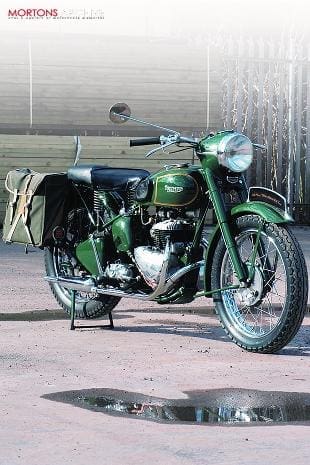 To get some appropriate shots of the Triumph, I rode up and down while Jimmy D took pictures, the TRW purring gently along at 25mph in top and all was well with the world. Until Mister Numpty intruded.
To get some appropriate shots of the Triumph, I rode up and down while Jimmy D took pictures, the TRW purring gently along at 25mph in top and all was well with the world. Until Mister Numpty intruded.
Riding past a row of parked cars, with Peter Beckwith and his mate Lenny Bowland looking on, I saw the nose of a car ease forward and hesitate. That’s OK, the driver’s waiting so you just move out a little to get around with room to spare. But he started coming out again and kept on coming, as the TRW came slowly alongside and I cut close across his bows. It’s the awkward streak in me, you see, and I do not take kindly to people who think they can push me out of their way. Particularly their illegal way.
On the other side of the road, a mighty angry Peter was running into the road waving his fist as I carried on down the road to U-turn and come back to discuss this rude interruption of a happy day. The driver had apparently been completely oblivious both to me on the bike and the owner, who was waving at the damned fool who didn’t seem to think it necessary to look and see if the road was clear. Didn’t see me? Didn’t look is the truth.
It would be less-than-discreet to tell you at this point which of the four riders discussing this minor incident admitted that he’d been known to carry a nut and bolt to lob at such intruders on his two-wheeled path, and I’m not going to admit having a used U2 battery in my tank top bag for the same purpose. I think we all agreed that every car driver under the sun is a fine human being who should be understood and tolerated, but I may have misunderstood some of the stronger words that were strange to such an innocent as myself. If the man had brought me down, I suspect he’d be limping still. And wouldn’t a bill for the restoration of genuine Rolls-Royce paintwork look good on his claims record?
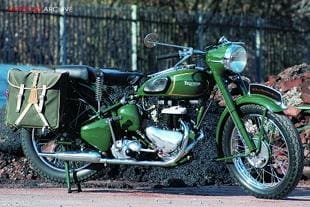 Deciding that Meriden might be less welcoming to motorcycles than it used to be, the TRW was pointed along the Fillongley road, one of the routes the lads in the old factory used to get to the Motor Industry Research Association test site. If memory serves me well, it was along here that Percy Tait was leading the way as a gang went off to get thoroughly tested, and swept gracefully through one of the S-bends at his usual rate of knots, which is another way of saying pretty fast. The next man along dumped it, and his mates arrived to find him sitting in the middle of the road and wailing: “If he can get round at that speed, why can’t I?” His mates knew the answer – Percy was one of those naturals who could get the best out of a bike, while the majority could only aspire to getting 80 or 85 per cent from it.
Deciding that Meriden might be less welcoming to motorcycles than it used to be, the TRW was pointed along the Fillongley road, one of the routes the lads in the old factory used to get to the Motor Industry Research Association test site. If memory serves me well, it was along here that Percy Tait was leading the way as a gang went off to get thoroughly tested, and swept gracefully through one of the S-bends at his usual rate of knots, which is another way of saying pretty fast. The next man along dumped it, and his mates arrived to find him sitting in the middle of the road and wailing: “If he can get round at that speed, why can’t I?” His mates knew the answer – Percy was one of those naturals who could get the best out of a bike, while the majority could only aspire to getting 80 or 85 per cent from it.
I extracted about 78 per cent of the TRW’s modest performance on that day. Peter Beckwith has wound it up to 70mph on the clock, and road tests of the period talked about 74mph or thereabouts. I had it against the stop along the famous Meriden Mile and again along the Fillongley road, and 55 was all it would grudgingly give me. The fact that I was sitting upright (this is a gentleman’s motorcycle, after all, and undignified antics such as tucking away don’t really suit its demeanour) partly explains this, and until I give up on the pies and pints there is a clear weight penalty. So 55 it was. But I’ve already stated that this is not a sporty machine; it’s a utilitarian animal, designed for ease of riding by squaddies doing a basic job. Mind you, this one did come in its Sunday best suit.
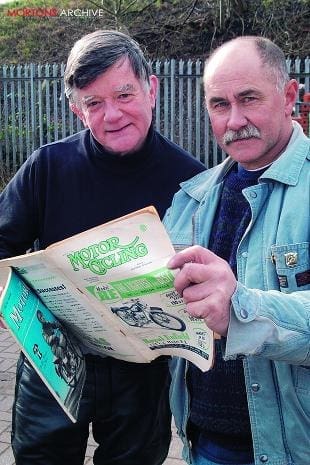 The TRW certainly covers ground easily. Peter had said its comfortable cruising speed is 45-50mph and it gets up to that rate reasonably quickly and sits there running very smoothly. Rigid frames may not have been the norm in a motorcycle built into the 1960s, but the resulting low build gives a motorcycle that can be put down a winding country road without much need to back off, and even less gear-changing. Acceleration from below 25 in top is improved by a drop into third but, if you’re on a weekend country cruise and there’s no hurry, you can roll the throttle off as you approach a bend and then feed the power back in progressively from the apex, making smooth and physically undemanding progress.
The TRW certainly covers ground easily. Peter had said its comfortable cruising speed is 45-50mph and it gets up to that rate reasonably quickly and sits there running very smoothly. Rigid frames may not have been the norm in a motorcycle built into the 1960s, but the resulting low build gives a motorcycle that can be put down a winding country road without much need to back off, and even less gear-changing. Acceleration from below 25 in top is improved by a drop into third but, if you’re on a weekend country cruise and there’s no hurry, you can roll the throttle off as you approach a bend and then feed the power back in progressively from the apex, making smooth and physically undemanding progress.
If you do need to stop, the seven-inch front brake is strong; strong enough to get the front end dipping and me wondering if the forks weren’t a mite underdamped. The rear stopper was OK as a stabilising influence on long bends, but the effectiveness of its brother up front made it redundant for most cross-country use. In all, the bike stopped better than a glance at the specification panel would suggest, a reflection of proper maintenance and regular use.
Peter’s maintenance is based on the original User Handbook issued by the factory, an early edition covering the Mark I and II models, but largely applicable to his Mark III version with its coil ignition system. That handbook came from Les Williams, mightily famous Triumph man and one-time member of the Royal Corps of Signals display team, where he was one of the men responsible for the maintenance of the team machines – TRWs before they switched to Tiger 100s and a bit more oomph for those high-speed rides across whatever stadium or field they were performing on.
 Williams was renowned at Triumph for playing jokes on his mates, a habit developed during his Army years. The White Helmets used to round their season off with a star spot at the Royal Tournament at Olympia, when the officer-in-charge would perform the daring jump through a blazing hoop of straw, no doubt impressing the adoring Knightsbridge totty no end. Cpl Williams was responsible for the jump ramp and the fire hoop and cunningly moved it one foot farther away from the starting-point every night, so the change wasn’t obvious but the cumulative effect was a bike going a little faster night after night, and the landing and braking area getting a little shorter. You can guess the rest – the officer-in-charge put it in the fence on the final night’s performance. Les Williams always was good at subtle tuning.
Williams was renowned at Triumph for playing jokes on his mates, a habit developed during his Army years. The White Helmets used to round their season off with a star spot at the Royal Tournament at Olympia, when the officer-in-charge would perform the daring jump through a blazing hoop of straw, no doubt impressing the adoring Knightsbridge totty no end. Cpl Williams was responsible for the jump ramp and the fire hoop and cunningly moved it one foot farther away from the starting-point every night, so the change wasn’t obvious but the cumulative effect was a bike going a little faster night after night, and the landing and braking area getting a little shorter. You can guess the rest – the officer-in-charge put it in the fence on the final night’s performance. Les Williams always was good at subtle tuning.
Back to this bike I was talking about earlier. The engine showed its other side when I tested its flexibility, something it would need for escort duty, and it would pull down to a brisk walking pace in first with the clutch fully engaged. It then did a U-turn in the two narrow lanes of Fillongley Road without the clutch, its trials frame heritage reflected in the easy feet-up way it did the trick. Excellent ease of operation. The gearbox was a slight disappointment, changes up and down the 2-3-4 sequence ranging from loud click to louder clunk every time, even though I tried a range of techniques from rapid change to slow and then to slower, and finally putting a little preload on the lever before shifting. The clutch was light in operation and never complained, just quietly getting on with its job; when you ride a well-maintained Meriden Triumph you realise why many speed men adapted their clutches to racers and sprinters in the 1950s.
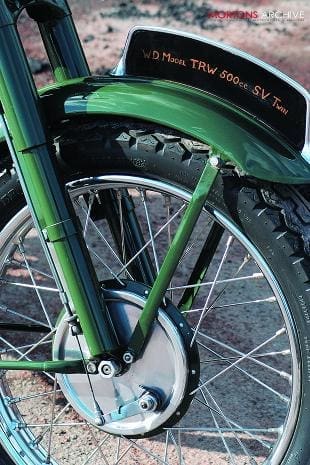 The handling of the rigid frame was fine, confirming Peter’s view that carrying its motive unit’s weight low down adds stability. The back end did step out when I was getting a bit enthusiastic around a bumpy roundabout, but there was no drama and it carried on. Then I remembered that the back tyre was due to be replaced, as the one I was riding on was fitted by the military, so it’s mature at best and original at worst. A 41-year-old tyre, eh? Must check the life insurance.
The handling of the rigid frame was fine, confirming Peter’s view that carrying its motive unit’s weight low down adds stability. The back end did step out when I was getting a bit enthusiastic around a bumpy roundabout, but there was no drama and it carried on. Then I remembered that the back tyre was due to be replaced, as the one I was riding on was fitted by the military, so it’s mature at best and original at worst. A 41-year-old tyre, eh? Must check the life insurance.
My time on this fine example of Triumph’s military model confirmed my opinion that it’s a sweet and lightweight bike, ideal for a newcomer or a veteran who’s finding it hard to kick-start his British single or big twin.
Starting this low compression engine couldn’t have been easier: you could almost spit on the kick-start and it would fire up. If you’re looking for a TRW, the problem could be finding a good one, because many have been adapted to Pre-65 trials use, or broken because their frames are the right basis for a Trophy replica.
Take an informed Triumph person along to look at any rigid 500 Trophy you’re tempted to buy, because there are TRW-based fakes about, which makes me sad that a machine with a noble pedigree is sometimes misused by the unscrupulous to build fiddle bikes they can offer to the gullible as genuine. You’ll know about caveat emptor, I’m sure.
Lovely, gentle, riding bike. Not flawless, but friendly and willing, which would make it a good partner for a mature rider.


